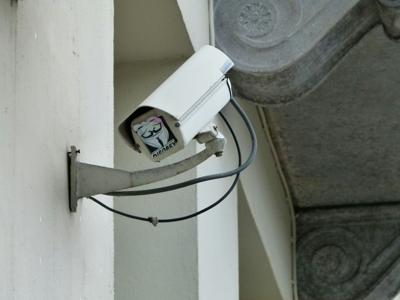
(Photo by Luiza Giannelli on Unsplash)
Under the renewed glare of increased federal funding and political urgency, the borders of the United States have evolved into vast digital landscapes.
U.S. Customs and Border Enforcement’s (CBP) wish list, obtained by The Intercept (July 23, 2025), includes AI-powered tools that can “see through walls,” detect movement within structures, and deploy drones to identify “suspicious activity” even in dense urban settings.
Meanwhile, Immigration and Customs Enforcement (ICE) has accelerated its expansion of surveillance. As widely reported, the agency has ordered GPS ankle monitors for nearly 180,000 immigrants in its Alternatives to Detention program—up from 24,000—turning private homes into “digital cages” without explanation or judicial oversight.
“People do not feel safe leaving their homes,” Celeste, creator of the ICE tracker called Stop Ice Alerts, said. “They don’t feel safe going to work, taking their children to school, going out to eat to their local Latine restaurant — people are ever afraid of opening the door to strangers in fear that it might be undercover feds.”
A broader picture emerges when surveying congressional funding: the so-called “One Big Beautiful Bill” allocates $6 billion toward border surveillance, biometric systems and tower deployments, with companies like Palantir, Anduril, LexisNexis and Clearview AI standing to profit substantially.
Already in motion: CBP is deploying autonomous towers—eyes that watch day and night across miles of borderland, identifying crossings before they begin. In the north, systems like NBRVSS (Northern Border Remote Video Surveillance System) observe vessel traffic far from shorelines, alerting agents to anomalies.
The Department of Homeland Security has revealed, quietly, that it supports at least 105 active AI use cases within immigration agencies, including 23 within ICE and dozens within CBP, spanning biometrics, social media scraping, email and video analysis and identity screening.
These technologies form a mosaic: facial recognition, drones, wall-penetrating sensors, license-plate readers, social media monitoring, data brokerage, biometrics and predictive analytics cohere into a surveillance regime that mirrors population flows more than it observes.
“We are an organization that comes out of the immigrant rights movement… a women of color-led organization… working closely with grassroots groups…” Daniel Werner, senior staff attorney of Just Futures Law, reminds us. Just Futures Law grounds this broader technological picture in material resistance: “We’ve been doing that work,” he says, “using legal tools and advocacy to support the immigrant-rights and racial-justice movements.”
Werner traces the lineage of surveillance tools back to earlier iterations: analytical systems like Palantir, once used under the Trump administration in the family-separation policy, are now being repurposed and expanded, their reach deeper and less transparent than before. “During the Biden administration,” he warns, “ICE and CBP have collected biometric information, even DNA, including from children”—a statement that, in its flat directness, carries the weight of systemic violation.
Werner describes how ICE has access to Mobile Fortify, a facial-recognition app used in the field, and automated license-plate readers that build detailed patterns of movement. ICE has contracts with data brokers, including LexisNexis, that allow it to access everyday consumer data—from utility payments to potentially deeply revealing personal information—all without direct oversight.
What alarms defenders of civil liberties, Werner underscores, is not just the presence of surveillance, but its expansion, opacity and punitive potential: “That is really, really dangerous… it functions as an intimidation tactic.” In Massachusetts, he notes, ICE is even on trial for targeting people based on their expression and speech.
“I think we are in a unique position to surveil the surveillers,” Celeste tells me, noting that her ICE tracker and all the consolidated reports help build a larger picture of patterns and then develop of a list of habits and places to avoid for immigrants like Home Depot, car washes and even places of worship.
“As individuals, we have very little power, it seems, when facing a federal agent; and it’s truly incredible the power of documenting what truly transpired during that interaction can have in raising awareness and even supporting a lawsuit,” she says.
So what can local groups do? Werner points to practical strategies rooted in organizing and civic empowerment:
Sunshine laws and FOIA requests can compel transparency—even if ICE appears unaccountable. He describes working with grassroots groups to use these tools effectively.
Local protective ordinances: Many local governments have privacy safeguards, yet loopholes remain, especially when data flows through third-party brokers. Local activists can push to shore up these gaps.
Long-standing campaigns like Mijente’s “No Tech for ICE” provide both education and resistance, helping communities understand and combat these technologies.
On the ground, in places like Chicago and Long Beach, coalitions like Communities Against Deportation and the Long Beach Anti-Surveillance Coalition have mobilized against data-broker loopholes and biometric overreach.
Border surveillance has shifted from the impersonal wall to the intimate spaces of the home, body, information and expression. While information activists continue to resist surveillance towers, every AI tool and every biometric pipeline through courtrooms, city halls, legal briefs, organizing meetings and community action.











(0) comments
Welcome to the discussion.
Log In
Keep it Clean. Please avoid obscene, vulgar, lewd, racist or sexually-oriented language.
PLEASE TURN OFF YOUR CAPS LOCK.
Don't Threaten. Threats of harming another person will not be tolerated.
Be Truthful. Don't knowingly lie about anyone or anything.
Be Nice. No racism, sexism or any sort of -ism that is degrading to another person.
Be Proactive. Use the 'Report' link on each comment to let us know of abusive posts.
Share with Us. We'd love to hear eyewitness accounts, the history behind an article.